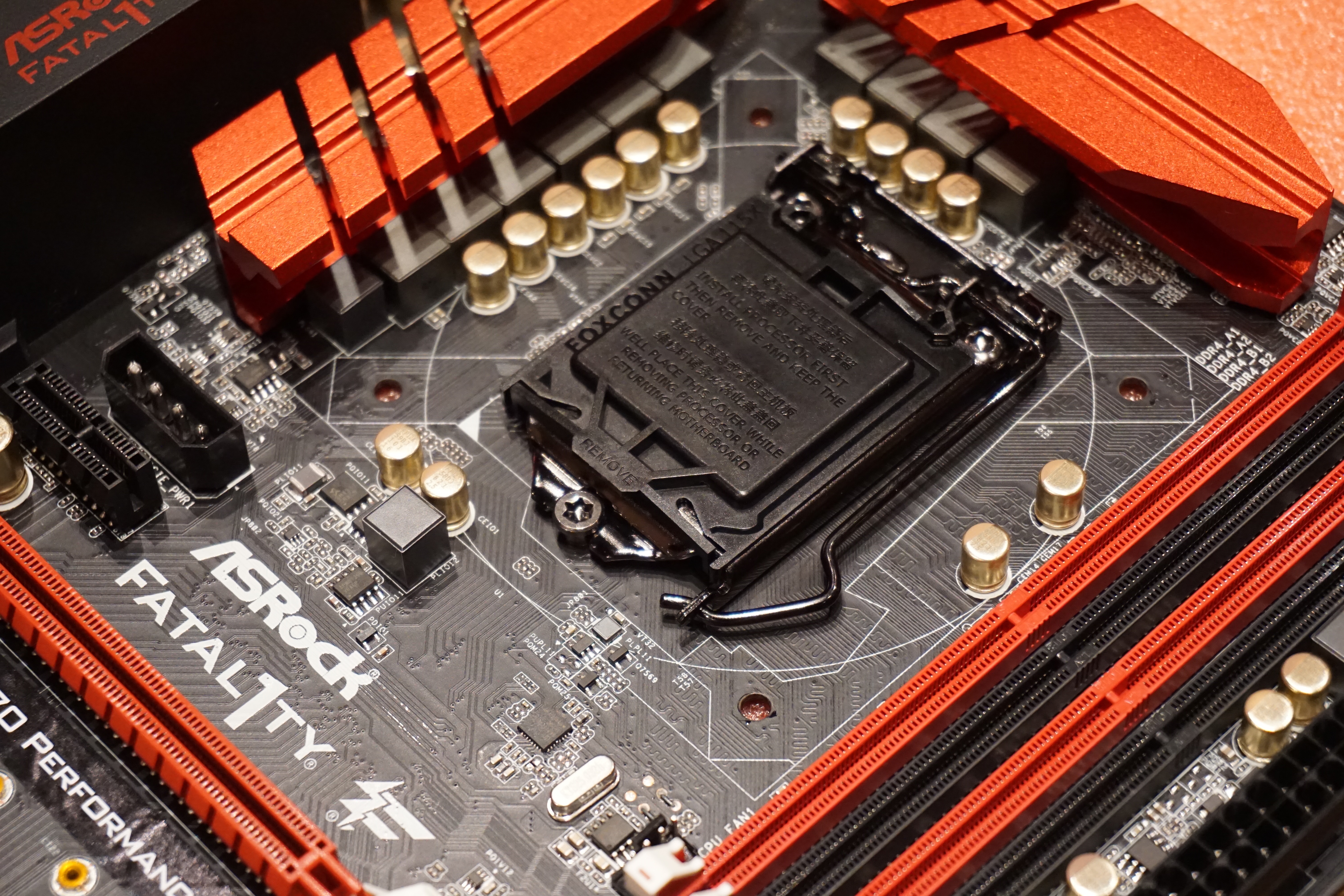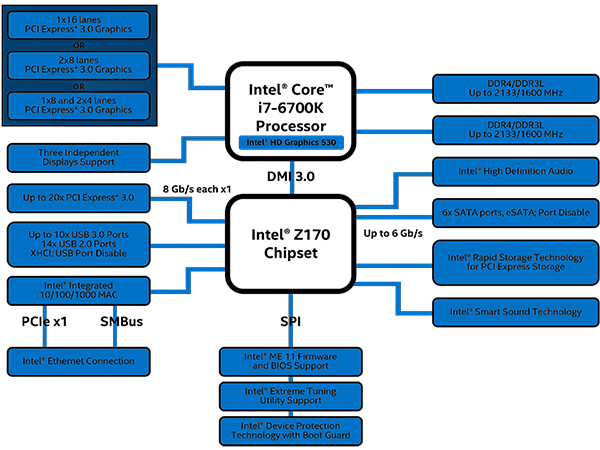Everything We Know About Intel's Skylake Platform
Intel's Skylake architecture and corresponding platform represent a huge evolution in connectivity, overclocking and, ultimately, system performance. This resource should help answer any questions you have about the company's current desktop PC design.
Skylake Consumer And Business Chipsets
Since the release of Intel's Skylake-based processors, we have been working tirelessly to learn everything there is to know about the architecture and its associated platform. The information we have accumulated over a number of months, but it seems to be constantly changing, creating confusion among tech enthusiasts. And so we're aiming to clear up conflicting information and condense everything we know about the Skylake platform down into a single resource.
Intel released a total of six chipsets targeting its consumer and business customers. These platform controller hubs follow the same structure used for years to cover Intel's relevant markets. Three are consumer-oriented SKUs and three are designed for business.
Skylake Consumer Chipsets
| Intel 100 Series Consumer Chipsets | |||
|---|---|---|---|
| Chipset | Z170 | H170 | H110 |
| CPU PCIe 3.0 Config Support | 1x16, 2x8 or 1x8 + 2x4 | 1x16 | 1x16 |
| Embedded Options | No | No | Yes |
| TDP | 6W | 6W | 6W |
| Recommended Customer Price | $47 | $32 | $26 |
| Independent Display Support | 3 | 3 | 2 |
| Memory Channels/ DIMMs per Channel | 2/2 | 2/2 | 2/1 |
| CPU Overclocking Support | Yes | No | No |
| Intel Smart Sound Technology | Yes | Yes | No |
| Intel Small Business Advantage 4.0 | No | Yes | No |
| Intel Small Business Basics | No | Yes | Yes |
| Intel RAID Support 0/1/5/10 | Yes | Yes | No |
| Intel Smart Response Technology | Yes | Yes | No |
| Max Intel RST for PCIe | 3 | 2 | 0 |
| I/O Port Flexibility | Yes | Yes | No |
| Maximum HSIO Lanes | 26 | 22 | 14 |
| Chipset PCIe Support | 20 PCIe 3.0 Lanes | 16 PCIe 3.0 Lanes | 6 PCIe 2.0 Lanes |
| USB Support (USB 3.0) | 14 (10) | 14 (8) | 10 (4) |
| SATA 6Gb/s Ports | 6 | 6 | 4 |
| DMI | 3.0 | 3.0 | 2.0 |
At the high end, we have the enthusiast Z170 chipset. In addition to featuring RAID 0/1/5/10, multi-GPU support and offering a wide selection of connection options, it is also the only PCH officially able to overclock Skylake-based processors. Z170 is followed up by the mid-range H170, which also offers a lot of I/O connectivity and RAID 0/1/5/10 functionality, but lacks overclocking and multi-GPU support via the CPU.
H170 is often advertised as supporting multiple graphics cards, but motherboards based on it can only run a multi-GPU setup in a x16/x4 configuration. This is because the PCH doesn't allow the CPU to divide its PCIe lanes between multiple devices. A second GPU can be connected over a four-lane PCIe 3.0 link through the PCH, which may be sufficient for some GPUs, but Nvidia doesn't let you enable SLI over a x4 connection.
At the bottom of the consumer chipset stack is H110, by far the most limited PCH. Instead of using a DMI 3.0 connection between the CPU and core logic, it employs the older DMI 2.0 technology. It's basically a budget-oriented approach to supporting Skylake-based processors.
Skylake Business Chipsets
| Intel 100 Series Business Chipsets | |||
|---|---|---|---|
| Chipset | Q170 | Q150 | B150 |
| CPU PCIe 3.0 Config Support | 1x16, 2x8 or 1x8 + 2x4 | 1x16 | 1x16 |
| Embedded Options | Yes | No | No |
| TDP | 6W | 6W | 6W |
| Recommended Customer Price | $47 | $43 | $28 |
| Independent Display Support | 3 | 3 | 3 |
| Memory Channels/ DIMMs per Channel | 2/2 | 2/2 | 2/2 |
| Intel SIPP Eligible | Yes | Yes | No |
| Intel vPro Technology Eligible | Yes | No | No |
| Intel Active Management Technology | Yes | No | No |
| Intel RAID Support 0/1/5/10 | Yes | No | No |
| Intel Smart Response Technology | Yes | No | No |
| Max Intel RST for PCIe | 3 | 0 | 0 |
| Maximum HSIO Lanes | 26 | 20 | 18 |
| USB Support (USB 3.0) | 14 (10) | 14 (8) | 12 (6) |
| SATA 6Gb/s Ports | 6 | 6 | 6 |
| Chipset PCIe Lanes | 20 PCIe 3.0 | 10 PCIe 3.0 | 8 PCIe 3.0 |
| DMI | 3.0 | 3.0 | 3.0 |
The business-oriented chipsets are similar to the consumer offerings, though they include a few extra features that consumers don't necessarily need.
Q170 is nearly identical to Z170, but of course lacks overclocking support. Moreover, it features Intel SIPP, vPro Technology and Active Management Technology. Q150 is nearly the same as H170 as well, except it has fewer HSIO and PCIe lanes. Plus it lacks RAID and Intel’s Small Business Basics software package. It is eligible for Intel’s SIPP technology, though.
The low-end B150 business chipset, however, does not match up well with H110. It offers more connectivity, DMI 3.0 and PCIe 3.0. Because of its budget price and specs, B150 is often used by consumers as a more feature-rich alternative to H110.
Get Tom's Hardware's best news and in-depth reviews, straight to your inbox.
MORE: Best CPUs
MORE: Intel & AMD Processor Hierarchy
MORE: All CPU Content
Current page: Skylake Consumer And Business Chipsets
Next Page Skylake Workstation Chipsets-
Captainawzome Reply
Thanks! Sadly, this page does not explain the nuances of other factors such as overclocking potential, and the probability of getting a skylake CPU that overclocks to 4.6, 4.8, etc17734443 said:Intel's Skylake architecture and corresponding platform represent a huge evolution in connectivity, overclocking and, ultimately, system performance. This resource should help answer any questions you have about the company's current desktop PC design.
Everything We Know About Intel's Skylake Platform : Read more
Very informational though! :)
-
logainofhades I suspect that if Zen is in any way successful, Intel will back off a bit, on the non z overclock stance. If they price a chip that is competitive, say at least on the same single threaded performance level as Haswell, with a locked i3 or i5, AMD will get a much needed boost in sales. I honestly hope something like this happens. This one side dominating completely, is bad for consumers.Reply -
IInuyasha74 Reply17734455 said:
Thanks! Sadly, this page does not explain the nuances of other factors such as overclocking potential, and the probability of getting a skylake CPU that overclocks to 4.6, 4.8, etc17734443 said:Intel's Skylake architecture and corresponding platform represent a huge evolution in connectivity, overclocking and, ultimately, system performance. This resource should help answer any questions you have about the company's current desktop PC design.
Everything We Know About Intel's Skylake Platform : Read more
Very informational though! :)
Well you see, it is hard to put a number on that which would hold up reliably. Overclocking chips could land just about anywhere, and without testing dozens of samples we couldn't come up with an average overclock that Skylake seems to be able to hit that would hold up well enough. -
kunstderfugue Hopefully the competition later this year makes Intel reconsider the way they're treating their consumers.Reply -
logainofhades Yea, I have not been very happy with Intel, since Skylake released. The Xeon chipset part, in particular, irked me. The whole launch has been a disaster of confusion. Glad this article was made to clear some things up.Reply -
TJ Hooker ASUS, MSI, and Gigabyte all ventured into non-k overclocking on their Z170 boards as well. The BIOSs that enabled it may have been labelled as betas, and I'm not sure if they're available through official channels anymore. But if Biostar gets a mention for releasing and then retracting non-k OC, I don't know why these other manufacturers aren't brought up.Reply
Another drawback of non-k BCLK OC is that CPU core temperature can no longer be read.
Lastly, another potential topic to add is the subject of DDR4 at speeds greater than 2133 MHz. I've seen many forum questions about what CPU/mobo support for running 2400+ MHz DDR4. I'm under the impression that you need a Z170 mobo (I could be wrong), I've seen people say you need an unlocked CPU (from personal experience I know this is wrong), could be handy to add a section to clear this up. -
josejones I am far more interested in articles about the soon to come Z270 motherboardsReply
200-Series Union Point Motherboards
http://www.tomshardware.com/forum/id-2983311/200-series-union-point-motherboards.html -
Jaran Gaarder Heggen Interresting article, but can you please add chipset for dual cpu xeon also in the Workstation area?Reply
-
hixbot ReplyI am far more interested in articles about the soon to come Z270 motherboards
You will be lucky to see Kaby Lake mobile before the end of 2016. It will be mid 2017 at the earliest before consumers can get their hands on desktop motherboards with Union Point.
200-Series Union Point Motherboards
http://www.tomshardware.com/forum/id-2983311/200-series-union-point-motherboards.html
Very hard to expect a detailed breakdown of that platform at this time.

